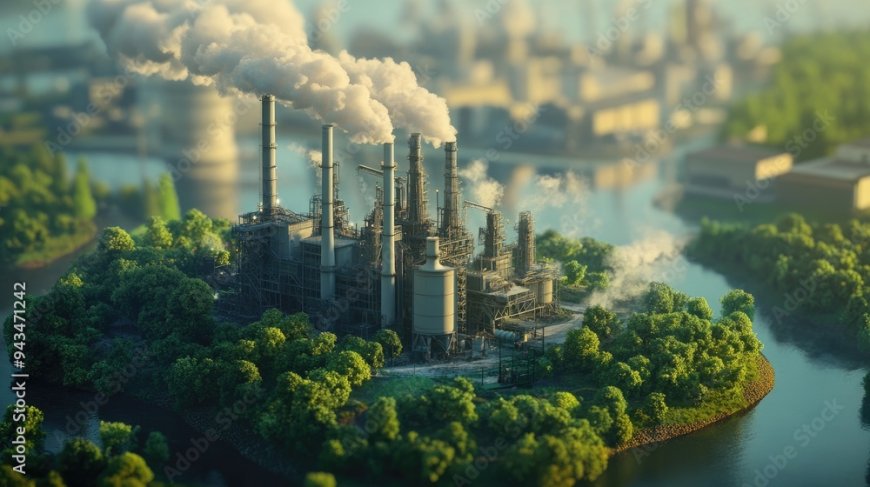Carbon Capture Technology: Can We Reverse Climate Change?
Explore how carbon capture technology is being used to fight climate change. Learn about CO₂ removal, direct air capture, and the future of carbon sequestration.

Climate change is accelerating, with rising global temperatures, extreme weather events, and shrinking ice caps becoming more evident each year. While reducing emissions is crucial, experts argue that cutting emissions alone may not be enough. To truly tackle climate change, we may need to go further—removing carbon dioxide (CO₂) from the atmosphere itself.
Enter Carbon Capture Technology (CCT)—a set of innovative solutions designed to capture, store, and even repurpose CO₂ before it contributes to global warming. But can this technology really reverse climate change, or is it just another expensive stopgap measure? Let’s explore the science, challenges, and future potential of carbon capture.
1. What is Carbon Capture Technology?
Carbon Capture Technology (CCT) refers to various methods that remove CO₂ from industrial emissions or directly from the air. The captured CO₂ can either be stored underground (carbon sequestration) or repurposed for industrial use.
There are three main types of carbon capture:
???? A. Pre-Combustion Capture
- Captures CO₂ before fuel is burned, typically in power plants or industrial facilities.
- Converts fossil fuels into hydrogen and CO₂, allowing the CO₂ to be separated and stored.
- More efficient but requires major infrastructure changes.
???? B. Post-Combustion Capture
- Captures CO₂ after fuel is burned, using chemical solvents to filter emissions from smokestacks.
- Can be retrofitted onto existing power plants.
- More expensive due to high energy requirements.
???? C. Direct Air Capture (DAC)
- Removes CO₂ directly from the atmosphere, rather than from smokestacks.
- Uses large air-scrubbing machines with chemical filters.
- Requires significant energy input, but can potentially remove historical emissions.
2. How Effective is Carbon Capture?
Carbon capture can reduce CO₂ emissions from power plants and factories by up to 90%, making it one of the most powerful tools available to combat climate change. However, its effectiveness depends on scalability, cost, and energy efficiency.
✅ Benefits of Carbon Capture
✔ Reduces Industrial Emissions – Captures CO₂ from power plants, cement factories, and steel production.
✔ Can Be Combined with Renewable Energy – Some DAC plants use solar and wind power to operate sustainably.
✔ Creates a Circular Economy – Captured CO₂ can be used to make fuel, plastics, or carbon-based materials.
❌ Challenges and Limitations
⏳ Energy-Intensive – Carbon capture requires significant energy, which can counteract its benefits.
???? Expensive – The cost of DAC is currently around $600 per ton of CO₂ captured, though this is expected to drop.
???? Storage & Transportation Issues – Safely storing CO₂ underground requires large-scale infrastructure and long-term monitoring.
3. Where is Carbon Capture Technology Being Used?
Despite challenges, carbon capture is already being implemented worldwide. Some key projects include:
???? A. Climeworks (Switzerland)
- One of the world’s leading Direct Air Capture (DAC) companies.
- Uses renewable energy to remove CO₂ from the air and store it underground.
???????? B. Petra Nova (USA)
- One of the largest post-combustion carbon capture plants in the world.
- Captures CO₂ from a coal power plant and uses it for enhanced oil recovery.
???????? C. Boundary Dam (Canada)
- The first full-scale carbon capture and storage (CCS) coal plant.
- Captures 90% of emissions, preventing 1 million tons of CO₂ per year from entering the atmosphere.
???????? D. Norway’s Northern Lights Project
- A $2.7 billion project that will store CO₂ under the North Sea.
- Aims to transport CO₂ emissions from Europe and store them underground.
4. Can Carbon Capture Reverse Climate Change?
While carbon capture is a powerful tool, it is not a silver bullet. To reverse climate change, we need:
1️⃣ Massive scaling of carbon capture projects to remove billions of tons of CO₂ per year.
2️⃣ Shifting towards renewable energy sources to prevent further emissions.
3️⃣ Investment in carbon utilization—turning captured CO₂ into useful products like fuels, concrete, and synthetic materials.
4️⃣ Regulatory support and carbon pricing to make carbon capture financially viable.
Scientists estimate that to meet global climate goals, we must remove 10 billion tons of CO₂ annually by 2050—a challenge that requires a mix of carbon capture, reforestation, and emission reductions.
5. The Future of Carbon Capture: What’s Next?
The carbon capture industry is rapidly evolving, with breakthroughs on the horizon:
???? Lower Costs – Advancements in materials and AI optimization could make carbon capture 5-10x cheaper in the next decade.
???? New Storage Methods – Researchers are exploring CO₂ storage in deep-sea rock formations and even turning CO₂ into solid rock.
???? Carbon-Neutral Fuels – Companies like Carbon Engineering are developing CO₂-derived jet fuel, making aviation more sustainable.
???? AI-Powered Optimization – AI and machine learning could optimize carbon capture efficiency, reducing energy use.
Governments and private companies are investing billions into these technologies, with Tesla, Microsoft, and ExxonMobil funding major carbon capture initiatives.
Conclusion: Is Carbon Capture the Answer?
Carbon Capture Technology is a promising tool in the fight against climate change, but it cannot replace emission reductions. Instead, it should be part of a larger strategy, including:
✅ Expanding renewable energy adoption
✅ Improving industrial efficiency
✅ Developing carbon-neutral fuels
✅ Implementing strict carbon regulations
While carbon capture alone won’t reverse climate change overnight, it represents one of our best hopes for addressing the damage already done. With continued investment, innovation, and policy support, we may be able to remove CO₂ at the scale needed to make a real impact.
???? The future of our planet depends on it.
What's Your Reaction?
 Like
0
Like
0
 Dislike
0
Dislike
0
 Love
0
Love
0
 Funny
0
Funny
0
 Angry
0
Angry
0
 Sad
0
Sad
0
 Wow
0
Wow
0



















































